6. Great Awakening, Seven Years War, Revolutionary Crisis
The Enlightenment, also called the Age of Reason, was an intellectual and cultural movement in the eighteenth century that emphasized reason over superstition and scientific empiricism over blind faith. Using the power of the press, Enlightenment thinkers like John Locke, Isaac Newton, and Voltaire questioned accepted knowledge and spread new ideas about openness, investigation, and religious tolerance throughout Europe and the Americas. Enlightenment ideas included rationalism, empiricism, progressivism, and cosmopolitanism. Rationalism is the idea that humans are capable of using their faculty of reason to gain knowledge; a sharp turn away from the prevailing idea that people needed to rely on scripture or church authorities for knowledge. Empiricism promotes the idea that knowledge comes from experience and observation of the world. Progressivism is the belief that through their powers of reason and observation, humans could make progress over time. Belief in the possibility of social progress was especially important after the carnage and upheaval of European religious wars and the English Civil Wars in the seventeenth century. Finally, cosmopolitanism reflected Enlightenment thinkers’ view of themselves as citizens of the world and actively engaged in it, as opposed to being provincial, close-minded, and ruled by prejudice.
The Englishman Thomas Paine and the American Benjamin Franklin are often thought of as representatives or embodiments of the Enlightenment in British America. Franklin was born in Boston in 1706 to a large Puritan family and went to work as apprentice to his older brother in a print shop, where he improved his writing by copying the style of the London Spectator, which his brother printed. At the age of seventeen, the rebellious Franklin ran away to Quaker Philadelphia. There he began publishing the Pennsylvania Gazette in the late 1720s, and in 1732 he started his annual publication Poor Richard: An Almanack. Franklin gave readers practical advice such as, “Early to bed, early to rise, makes a man healthy, wealthy, and wise.” Thomas Paine, about two decades younger than Franklin, grew up in England and worked as an excise (tax) officer and political pamphleteer before being introduced to Franklin in London. Franklin encouraged Paine to emigrate to America and wrote him a letter of introduction. Paine moved to Philadelphia and became editor of the Pennsylvania Magazine in 1775, just in time to participate in the America’s movement toward independence.
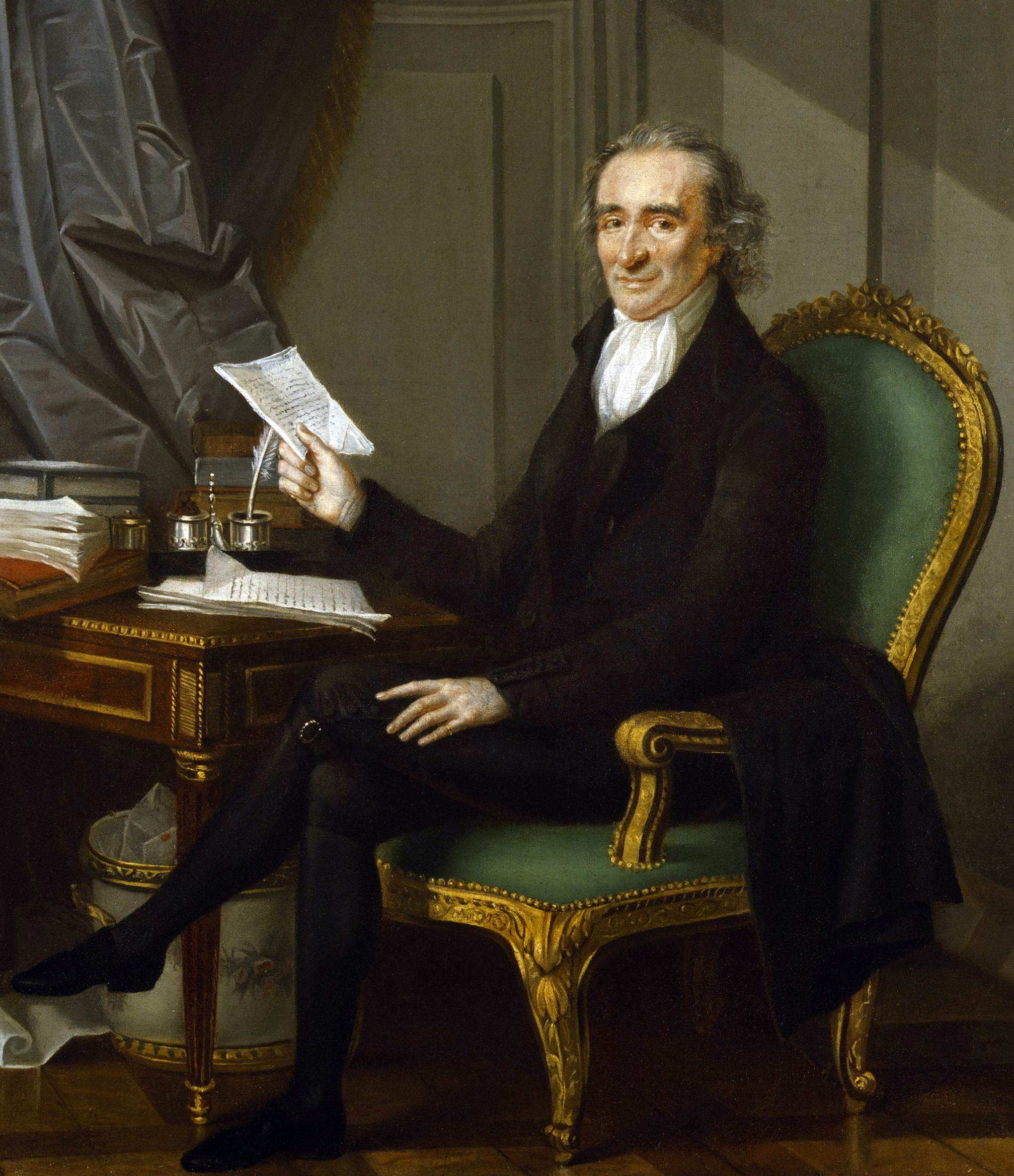
Franklin and Paine both rejected organized religion, preferring deism, an Enlightenment-era belief in an impersonal God who may have created but had no continuing involvement with the world and the events within it. Deists held that personal morality was more important than strict church doctrines. Franklin’s deism guided many philanthropic projects. In 1731, he established a reading library that became the Library Company of Philadelphia. In 1743, he founded the American Philosophical Society to encourage the spirit of inquiry. In 1749, Franklin provided the foundation for the University of Pennsylvania, and in 1751, he helped found Pennsylvania Hospital. Paine’s Deism drove him to support the American Revolution and later the French Revolution and to attack state religion in books like The Age of Reason.
The reach of Enlightenment thought even prompted the founding of a new colony. Having witnessed the terrible conditions of debtors’ prisons and poverty of the streets of London, James Oglethorpe, a member of Parliament and advocate of social reform, petitioned King George II for a charter to start a new colony. The king understood the strategic advantage of a British colony positioned as a buffer between South Carolina and Spanish Florida, and granted a charter to Oglethorpe and twenty like-minded proprietors in 1732. Oglethorpe led the settlement of the colony, which was called Georgia in honor of the king. In 1733, he and 113 immigrants arrived and over the next decade, Parliament funded the migration of twenty-five hundred settlers, making Georgia the only government-funded colonial project. Oglethorpe’s vision for Georgia followed the ideals of the Enlightenment: he saw the colony as a place for England’s “worthy poor” to start anew. To encourage industry, he gave each male immigrant fifty acres of land, tools, and a year’s worth of supplies. In Savannah, the Oglethorpe Plan provided for a utopia: “an agrarian model of sustenance while sustaining egalitarian values holding all men as equal.” Oglethorpe’s vision of a just society ruled out alcohol and slavery. However, settlers who migrated into Georgia from South Carolina disregarded these prohibitions. Despite its proprietors’ early vision of a colony guided by Enlightenment ideals and free of slavery, by the 1750s, Georgia was shipping rice into the Atlantic commercial market grown and harvested by slaves.
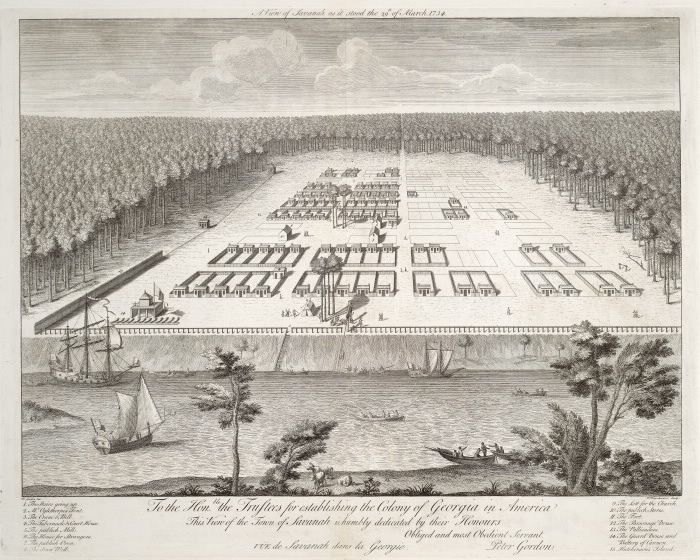
Questions for Discussion
- Was the Deism of people like Franklin and Paine a positive or negative influence on their actions?
- How might history have been different if Oglethorpe’s idealistic vision for Georgia had succeeded?
The British colonies grew during a time when much of North America, especially the Northeast, engaged in frequent war. Generations of colonial families knew battle firsthand. In the eighteenth century, fighting was seasonal. Armies mobilized in the spring, fought in the summer, and retired to winter quarters in the fall. The British army imposed harsh discipline on its soldiers, who were drawn from the poorer classes, to ensure they did not step out of line during engagements. If they did, their officers would kill them. On the battlefield, armies dressed in bright uniforms to advertise their lack of fear. They stood in tight formation and exchanged volleys of close-range musket-fire with the enemy. In reality, troops often feared their officers more than the enemy.
Most imperial conflicts had both American and European fronts, leaving history with two or more names for each war. For instance, King William’s War (1688–1697) is also known as the War of the League of Augsburg. In America, the bulk of the fighting in this conflict took place between New England and New France. Queen Anne’s War (1702–1713) is also known as the War of Spanish Succession. England fought against both Spain and France over who would inherit the Spanish throne after the last Hapsburg ruler died. In North America, fighting took place in Florida, New England, and New France. In Canada, the French prevailed but lost Acadia and Newfoundland. The English failed to take Quebec, which would have given them complete control of Canada. Queen Anne’s War is best remembered in the United States for the French and Indian raid against Deerfield, Massachusetts, in 1704. A small French force, combined with a native group made up of Catholic Mohawks and Pocumtucs, attacked the frontier village of Deerfield, killing scores and taking 112 prisoners. Among the captives was the seven-year-old daughter of Deerfield’s minister John Williams, named Eunice. She lived with the Mohawks for years as her family tried to ransom her and became assimilated into the tribe. To the horror of the Puritan leaders, when she grew up Eunice married a Mohawk man and refused to return to New England.
Possession of Georgia and trade with the interior was the focus of the War of Jenkins’ Ear (1739–1742), a conflict between Britain and Spain over claims to the land occupied by the fledgling Georgia colony between South Carolina and Florida. King George’s War (1744–1748), known in Europe as the War of Austrian Succession (1740–1748), was fought in the northern colonies and New France. In 1745, the British took the massive French fortress at Louisbourg on Cape Breton Island, Nova Scotia. However, three years later, under the terms of the Treaty of Aix-la-Chapelle, Britain relinquished control of the fortress to the French.

The final imperial war, the French and Indian War (1754–1763), known as the Seven Years’ War (1756–1763) in Europe, was the decisive contest between Britain and France in America. It began over rival claims along the frontier in present-day western Pennsylvania. Well-connected planters from Virginia (including a young George Washington) faced stagnant tobacco prices and hoped speculating in land on the western frontier would stabilize their wealth and status. They established the Ohio Company of Virginia in 1748, and the British crown granted the company half a million acres in 1749. However, the French also claimed the lands granted to the Ohio Company, and to protect the region they established Fort Duquesne in 1754, where the Monongahela and Allegheny Rivers met to form the Ohio River.
Twenty-two-year-old Virginian George Washington, a planter’s son whose family had helped start the Ohio Company, apparently started the war with a command to his men to fire on French soldiers near present-day Uniontown, Pennsylvania. Fighting broke out along the frontier of New France and British America from Virginia to Maine. The war also spread to Europe and Asia as France and Britain fought to gain supremacy for their empires. The British fought poorly in the first years of the war and in 1754 the French and their native allies forced Washington to surrender at Fort Necessity, a hastily built fort constructed after his attack on the French. In 1755, Britain dispatched General Edward Braddock to the colonies to take Fort Duquesne. The French, aided by the Potawotomis, Ottawas, Shawnees, and Delawares, ambushed fifteen hundred British soldiers and Virginia militia as they marched toward the fort. The attack killed hundreds of Virginia militiamen and British soldiers, including General Braddock. The only British victory in 1755 was the capture of Nova Scotia. In 1756 and 1757, Britain suffered further defeats with the fall of Fort Oswego and Fort William Henry.
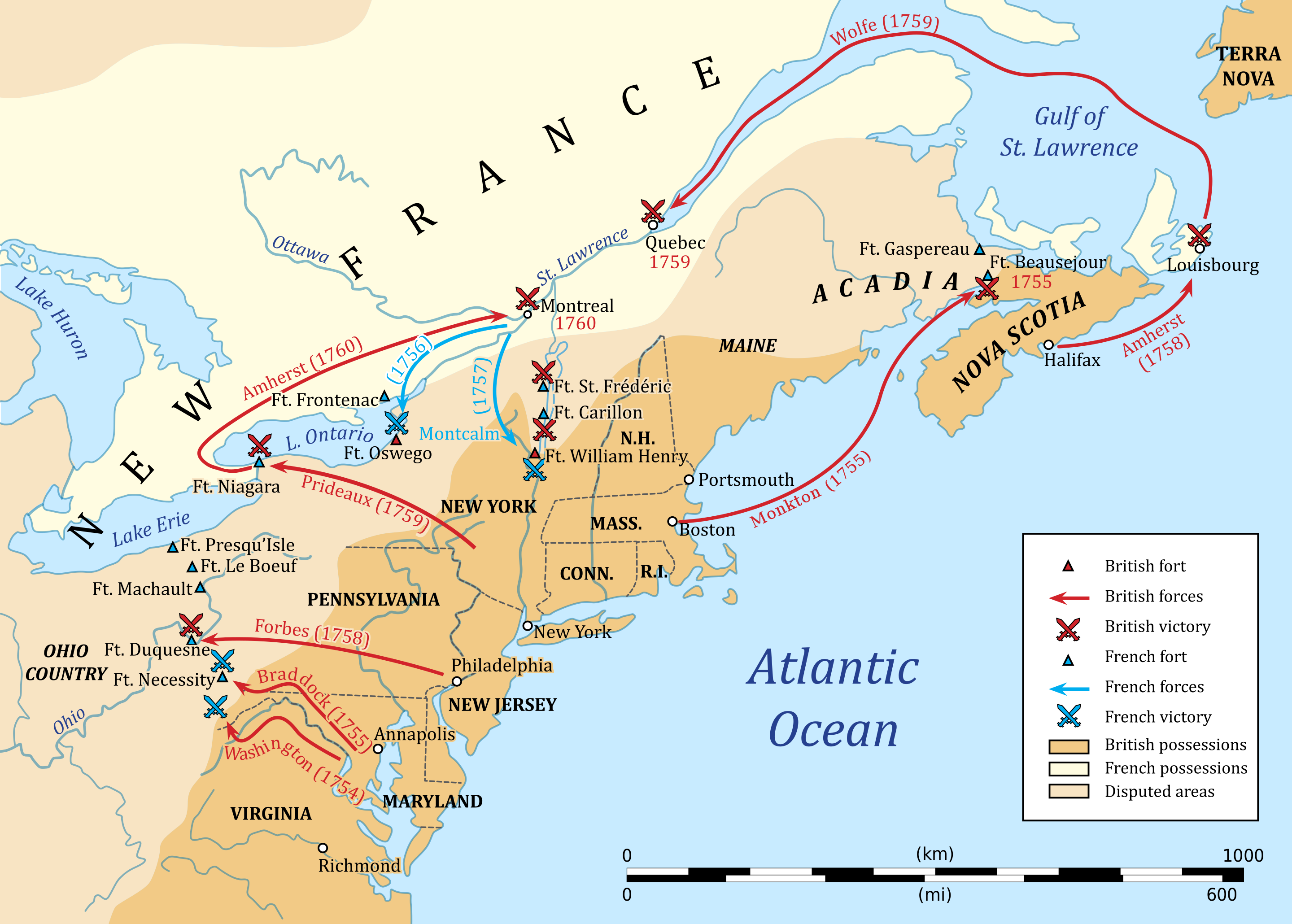
The war began to turn in favor of the British in 1758, due in large part to the efforts of William Pitt, a very popular member of Parliament. Pitt pledged huge sums of money and resources to defeating the French and Great Britain spent part of the money on bounties paid to new recruits in the colonies, helping invigorate the British forces. In 1758, the Iroquois, Delaware, and Shawnee signed the Treaty of Easton, aligning themselves with the British in return for some contested land around Pennsylvania and Virginia. In 1759, the British took Quebec, and in 1760, Montreal. The French empire in North America crumbled, but the war continued until 1763 when the French signed the Treaty of Paris. New France ceased to exist and the British Empire gained control over North America. The Empire not only gained New France under the treaty; it also acquired French sugar islands in the West Indies, French trading posts in India, and French-held outposts on the west coast of Africa. The English victory in the French and Indian War made Great Britain a truly global empire. Fort Duquesne, on the western frontier, was renamed Fort Pitt (later Pittsburgh) after the war’s champion in Parliament.
In the American colonies, ties with Great Britain were closer than ever. Professional British soldiers had fought alongside Anglo-American militiamen, creating a greater sense of shared identity. Colonial pride ran high as colonists sang “Rule, Britannia” and celebrated their identity as British subjects. Despite the celebratory mood, however, the victory over France produced massive war debt that became a serious problem for Parliament. The frontier had to be secure in order to prevent another costly war. Greater enforcement of imperial trade laws had to be put into place. Parliament had to raise revenue to pay for the war. Everyone was expected to contribute their share, including British subjects across the Atlantic. British territorial holdings now extended from Canada to Florida, and Britain’s military focus shifted to maintaining peace in the king’s newly enlarged lands. However, much of the land in the American British Empire remained under the control of powerful native confederacies, which made claims of British dominion beyond the Atlantic coastal settlements hollow.
Great Britain quartered ten thousand troops in North America after the war ended in 1763 to defend the borders and repel any attack by their imperial rivals. British colonists, eager for fresh land, poured over the Appalachian Mountains to stake claims. The western frontier had long been a “middle ground” where different imperial powers (British, French, Spanish) had interacted and compromised with native peoples. That era of accommodation in the “middle ground” came to an end after the French and Indian War. Virginians (including George Washington) and other land-hungry colonists had already raised tensions in the 1740s with their quest for land. Virginia landowners eagerly looked to diversify their holdings beyond tobacco, which had stagnated in price and had exhausted the fertility of the lands along Chesapeake Bay. They invested heavily in the newly available land.
This explosion of westward settlement brought the colonists into conflict as never before with Indian tribes like the Shawnee, Seneca-Cayuga, Wyandot, and Delaware, who were increasingly willing to fight to hold their ground against any further intrusion by white settlers. The treaty that ended the war between France and Great Britain was a disastrous blow to native peoples. With the French defeat, tribes who had sided with France lost an ally and trading partner as well as bargaining power over the British. After the war, British troops took over the former French forts but failed to court favor with the local tribes by distributing gifts as the French had done. They also significantly reduced the amount of gunpowder and ammunition they sold to the Indians, worsening relationships further.
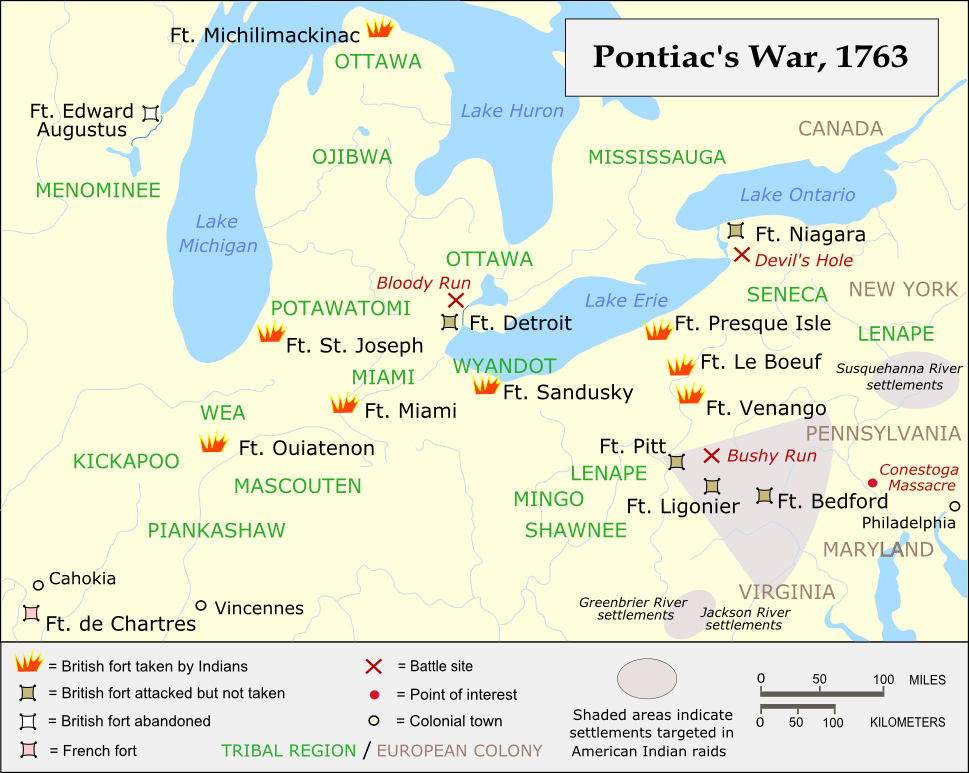
Indian resistance to colonists grew around the teachings of Delaware prophet Neolin and the leadership of Ottawa war chief Pontiac. Neolin preached a doctrine of shunning European culture and expelling Europeans from native lands. Pontiac echoed this idea, exhorting tribes to join together against the British: “It is important for us, my brothers, that we exterminate from our lands this nation which seeks only to destroy us.” In a broad-based alliance that came to be known as Pontiac’s Rebellion, the Ottawa warrior led a loose coalition of tribes against the colonists and the British army. The conflict began in 1763, when Pontiac and several hundred Ojibwas, Potawatomis, and Hurons laid siege to Fort Detroit while Senecas, Shawnees, and Delawares besieged Fort Pitt. Over the next year, the war spread along the backcountry from Virginia to Pennsylvania. Pontiac’s Rebellion triggered horrific violence on both sides. Stories of brutal attacks incited a deep racial hatred in the colonists against all Indians.
The actions of a group of settlers from Paxton, Pennsylvania, in December 1763, illustrates the deadly effects of white hatred of all Indians. A mob of Scots-Irish frontiersmen known as the Paxton Boys attacked a nearby village of Conestoga Indians of the Susquehannock tribe. The Conestoga had lived peacefully with local settlers, but the Paxton Boys viewed all Indians as savages and they brutally murdered six Indians and burned their homes. When Governor John Penn put the remaining fourteen Conestoga in protective custody in Lancaster, Pennsylvania, the Paxton Boys broke into the building and killed and scalped all the Indians they found there. Although Governor Penn offered a reward for the capture of any Paxton Boys involved in the murders, no one ever identified the attackers. Some colonists reacted to the incident with outrage. Benjamin Franklin warned that “the Wickedness cannot be covered, the Guilt will lie on the whole Land, till Justice is done on the Murderers. The blood of the innocent will cry to heaven for vengeance.” Yet, as the inability to bring the perpetrators to justice clearly indicates, the Paxton Boys had many more supporters than critics.
Pontiac’s Rebellion and the Paxton Boys’ actions were examples of early American race wars, in which both sides saw themselves as inherently different from the other and believed the other needed to be eradicated. But the response of the Indians defending their homeland from invaders should not be equated with the attitudes of the British, who regarded the natives as a lesser race to be moved out of the way of progress. In a letter suggesting “gifts” to the natives of smallpox-infected blankets, British Field Marshal Jeffrey Amherst instructed one of his Colonels, “You will do well to inoculate the Indians by means of blankets, as well as every other method that can serve to extirpate this execrable race.” Amherst, who gave his name to several towns and a college in New England, was ennobled by the British crown and became the first Baron Amherst. Pontiac’s Rebellion came to an end in 1766, when it became clear that the French, whom Pontiac had hoped would side with his forces, would not be returning to the fight. The repercussions, however, would last much longer. Race relations between Indians and whites remained poisoned on the frontier.
Well aware of the problems on the frontier, the British government took steps to try to prevent another costly war.
Questions for Discussion
- Why were European imperial conflicts often fought on American soil?
- How did Britain’s defeat of France in the Seven Years War affect Indians?
At the beginning of Pontiac’s uprising, the British issued the Proclamation of 1763, forbidding white settlement west of a borderline running along the spine of the Appalachian Mountains. Setting the Proclamation Line was an attempt to forestall further conflict on the frontier but British colonists who had hoped to move west objected to this restriction. The Americans believed they had just fought and won a war to ensure their right to settle the west. The Proclamation Line was a barrier to both the settlers’ and the land speculators’ visions of profits from westward expansion.
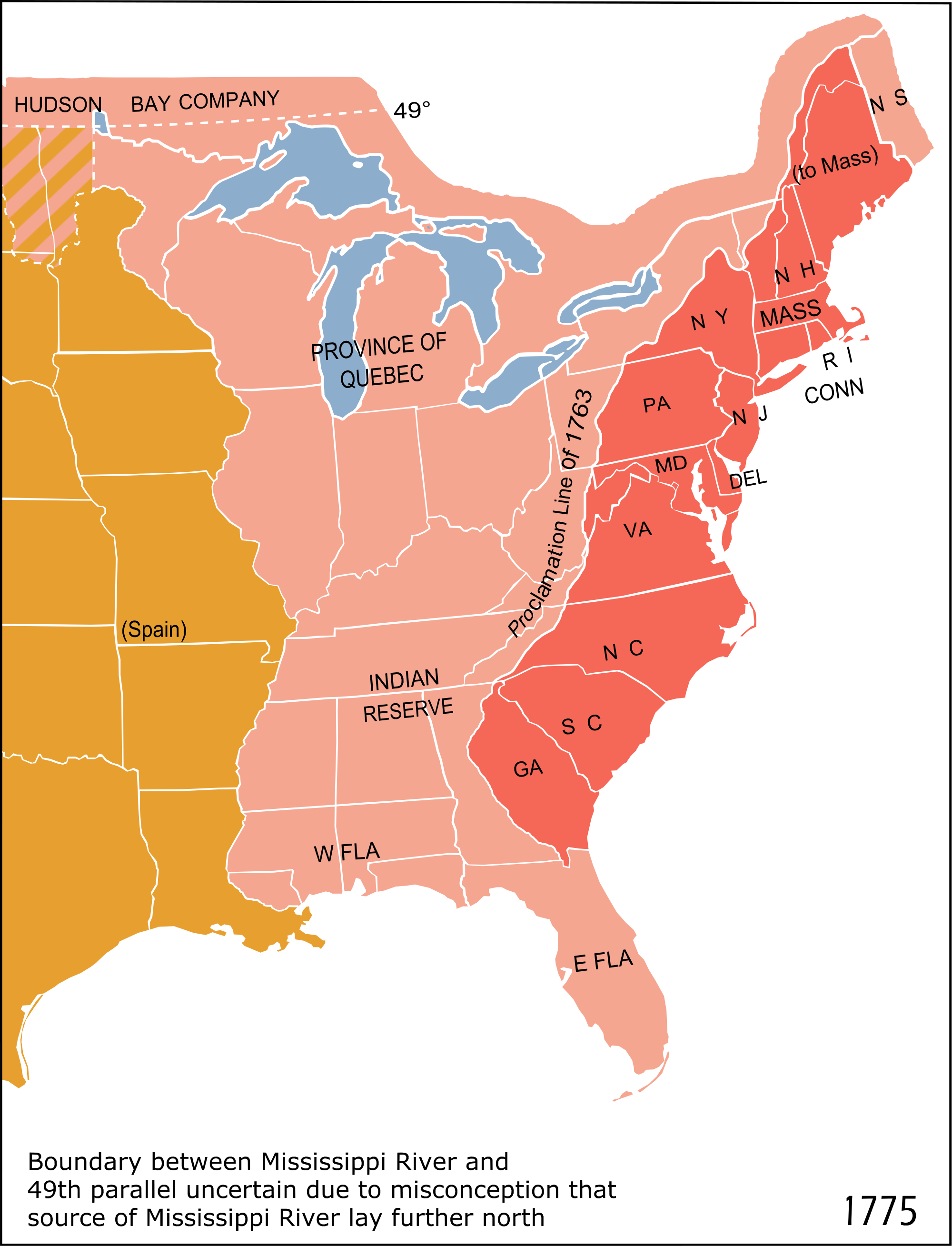
Great Britain’s newly-enlarged empire came with a price-tag that nearly doubled the British national debt from £75 million in 1756 to £133 million in 1763. Interest payments alone consumed over half the national budget, and the ongoing military presence in North America was a constant financial drain. The Empire needed more revenue and members of Parliament in Great Britain believed British subjects in North America should certainly shoulder their share of the financial burden. The British government began increasing revenues by raising taxes, even as interest groups at home lobbied to keep their own taxes low. Powerful aristocrats, well represented in Parliament, successfully prevented the government raising taxes on land. The new tax burden, instead, fell on the lower classes in the form of increased duties that raised the prices of imports like sugar and tobacco. A new Whig government under Prime Minister George Grenville promised to rein in government spending and make sure the American colonists did their part to pay down the massive debt. Grenville introduced the Currency Act of 1764, prohibiting the colonies from printing their own paper money and bringing American economic activity under greater British control. Grenville also pushed Parliament to pass the Sugar Act of 1764, which actually lowered duties on British molasses by half, from six pence per gallon to three, but which required violators of the Navigation Acts to be tried in vice-admiralty courts, tribunals that operated without juries. Some colonists argued that trial by jury had long been honored as a basic right of Englishmen. Depriving defendants of a jury, they contended, meant reducing liberty-loving British subjects to political slavery. To make their arguments seem more dramatic, some colonists equated this loss of liberty to the enslavement of Africans.

Parliament was in charge of taxation, and although it was a representative body, the colonies did not have direct representation in it. Protesters viewed themselves as having the same right as all British subjects to avoid taxation without their consent. The colonists ignored the fact that if they had been represented in the House of Commons, their representatives would not have been able to prevent the imposition of these new taxes. But for the British government, the colonists’ objections were beside the point. Parliament believed the relationship of the colonies to the Empire was one of dependence, not equality. The Stamp and Quartering Acts had the unintended consequence of drawing colonists from very different areas and viewpoints together in protest. In Massachusetts, for instance, James Otis, a lawyer and defender of British liberty, became the leading voice for the idea that “Taxation without representation is tyranny.” In the Virginia House of Burgesses, slaveholder Patrick Henry introduced the Virginia Stamp Act Resolutions, which denounced the Stamp Act and the British crown in language so strong that some conservative Virginians accused him of treason. And although the Stamp Act taxed documents and most impacted publishers, lawyers, and other professionals, the Quartering act affected people of all classes and turned the British troops that had recently been brothers in arms to the colonists into an expensive imposition.

The residents of Britain’s thirteen colonies had never before formed a unified political front, so Grenville and Parliament did not consider them capable of acting together. However, in response to the Stamp Act, the Massachusetts Assembly sent letters to the other colonies asking them to send delegates to a congress. Many American colonists from very different colonies found common cause in their opposition to the Stamp Act. Representatives from nine colonial legislatures met in New York in the fall of 1765 to reach a consensus. The Congress drafted a rebuttal to the Stamp Act, making clear that they desired only to protect their liberty as loyal subjects of the Crown. The document, called the “Declaration of Rights and Grievances”, outlined the unconstitutionality of taxation without representation and trials without juries. Meanwhile, popular protest was also gaining force.
Questions for Discussion
- Why did colonists object tot he Proclamation Line?
- Do you think the colonists were justified in objecting to pay 17% of the cost of the soldiers protecting the colonies?
The Stamp Act Congress was a gathering of landowning, educated white men who represented the social and political elites of the colonies; the colonial equivalent of the British aristocracy. While these gentlemen were drafting their grievances during the Stamp Act Congress, other colonists showed their distaste for the new act by boycotting British goods and protesting in the streets. Two groups, the Sons of Liberty and the Daughters of Liberty, led the popular resistance to the Stamp Act. Forming in Boston in the summer of 1765, the Sons of Liberty were artisans, shopkeepers, and merchants. Although the group’s members were common people, many of its leaders were lawyers like James Otis and Patrick Henry, doctors like Joseph Warren and Thomas Young, or businessmen like Benedict Arnold and John Hancock who were apparently not above encouraging their group to violent protest. Before the Stamp Act even went into effect, the Sons of Liberty began protesting. On August 14, they took aim at Andrew Oliver, who had been named the Massachusetts Distributor of Stamps. After hanging Oliver in effigy, the unruly crowd stoned and ransacked his house, then beheaded the effigy and burned the remains. Andrew Oliver resigned the next day. By that time, the mob had surrounded the home of Lieutenant Governor Thomas Hutchinson, barricaded Hutchinson in his home and demanded that he renounce the Stamp Act. When Hutchinson refused the protesters looted and burned his house. The Sons of Liberty continued to lead violent protests with the goal of forcing the resignation of all appointed stamp collectors.
Formed in early 1766, the Daughters of Liberty took a less violent path. They protested the Stamp Act by refusing to buy British goods and boycotting British tea, opting to make their own teas with local herbs and berries. Well-born women held “spinning bees,” at which they competed to see who could produce the most homespun linen. The Daughters’ non-importation movement broadened the protest against the Stamp Act, giving women a new, active role in the political dissent of the time. Although women could not vote or hold official positions, they could vote with their purses, mobilize others, and make a difference in the political landscape. The Sons and Daughters of Liberty spread rapidly until there was a chapter in every colony. The Daughters of Liberty promoted the boycott on British goods while the Sons enforced it, threatening retaliation against anyone who bought imported goods or used stamped paper. In the protest against the Stamp Act, wealthy political figures like attorney John Adams supported the goals of the Sons and Daughters of Liberty, even if they did not engage in the Sons’ violent actions. Lawyers, printers, and merchants ran a propaganda campaign parallel to the Sons’ campaign of violence. In newspapers and pamphlets throughout the colonies, they published the reasons the Stamp Act was unconstitutional and urged peaceful protest. The colonial elites officially condemned violent actions but did not have the protesters arrested; a degree of cooperation prevailed, despite the groups’ different economic backgrounds.
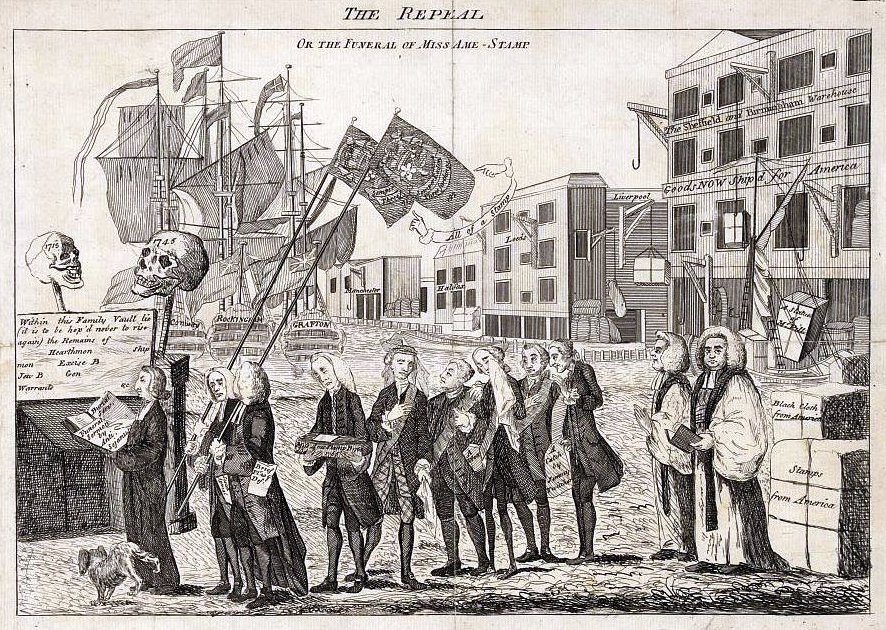
In Great Britain, news of the colonists’ reactions to the new laws worsened an already volatile political situation. Grenville’s imperial reforms had already increased domestic taxes and his unpopularity led to his dismissal by King George III. While many in Parliament still wanted such reforms, British merchants argued for their repeal. Non-importation of British goods by North American colonists was hurting their business. In March 1766, the new prime minister, Lord Rockingham, forced Parliament to repeal the Stamp Act. Colonists celebrated what they saw as a victory for their British liberty; in Boston, merchant John Hancock treated the entire town to drinks. However, to appease those who feared the repeal would weaken parliamentary power over the American colonists, Rockingham also proposed the Declaratory Act which stated that Parliament’s power was supreme and that any laws the colonies may have passed to govern and tax themselves were null and void if they ran counter to parliamentary law.
Lord Rockingham’s tenure as prime minister only lasted a year. British landowners feared that if he did not raise enough revenue in the colonies, Parliament would raise their taxes instead. His successor, William Pitt, was sympathetic to the colonists but old and ill. Pitt’s chancellor of the exchequer, Charles Townshend, took on the duty of raising the needed revenue from the colonies. Townshend proposed the Restraining Act of 1767, which disbanded the New York Assembly that had voted not to pay for the garrison of British soldiers until it agreed to obey the Quartering Act’s requirements. The Townshend Revenue Act of 1767 placed duties on consumer items like paper, paint, lead, tea, and glass that the colonies did not manufacture themselves. The Indemnity Act of 1767 exempted tea produced by the British East India Company from taxation when it was imported into Great Britain. When the tea was re-exported to the colonies, however, the colonists had to pay taxes on it because of the Revenue Act. Critics of Parliament on both sides of the Atlantic saw this tax policy as an example of corrupt politicians giving preferable treatment to specific corporate interests, creating a monopoly.
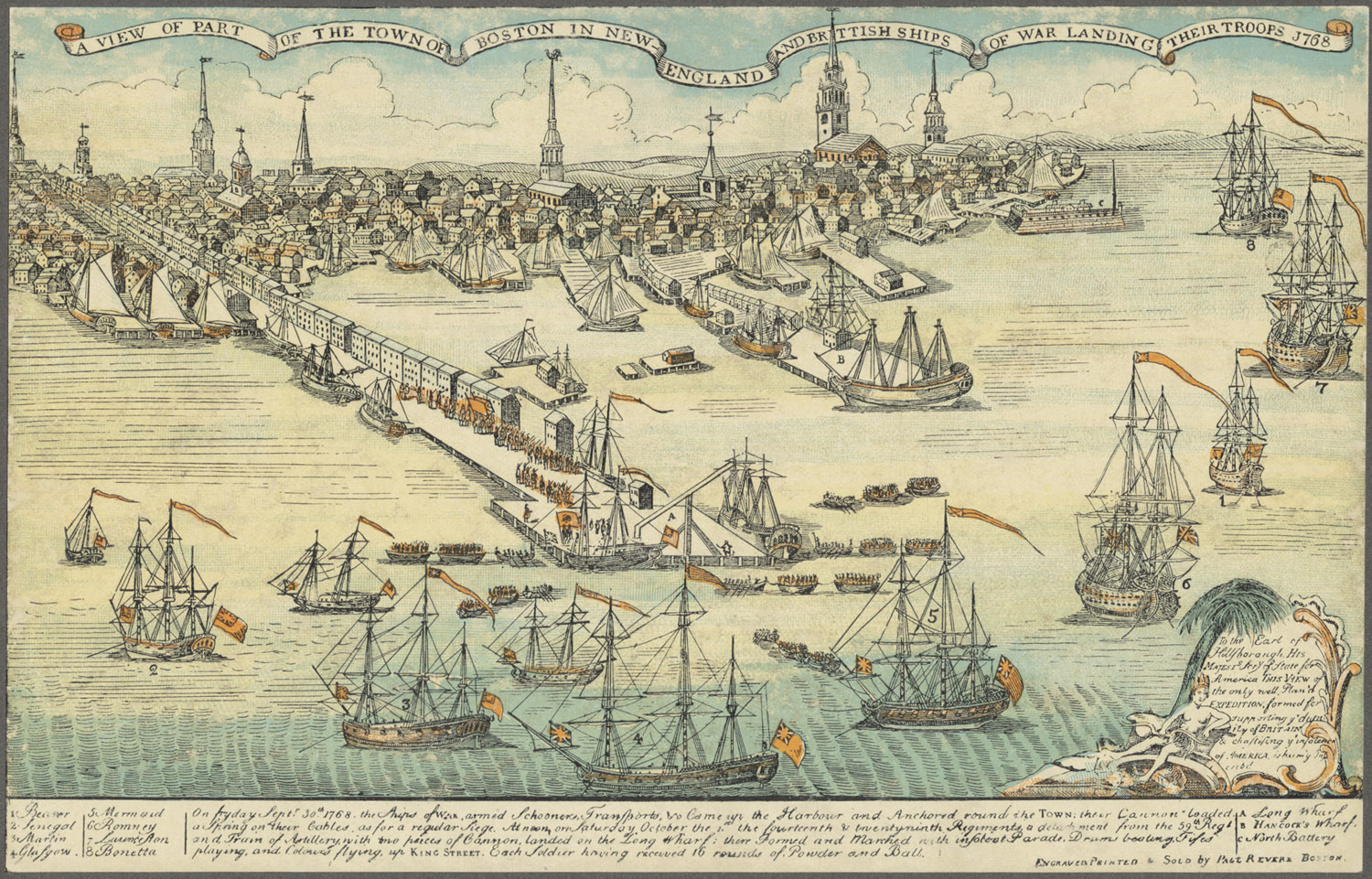
To ensure compliance with his Revenue Act, Townshend introduced the Commissioners of Customs Act of 1767, which created an American Board of Customs to enforce trade laws. Customs enforcement had been based in Great Britain, but rules were difficult to implement at such a distance and smuggling was rampant. The new customs board was based in Boston and severely curtailed smuggling. Townshend also orchestrated the Vice-Admiralty Court Act, which established three more vice-admiralty courts, in Boston, Philadelphia, and Charleston, to try violators of customs regulations without a jury. Since the judges of these courts were paid a percentage of the value of the goods they recovered, leniency was rare.
The Townshend Acts resulted in higher taxes and stronger British power to enforce them. Like the Stamp Act, the Townshend Acts triggered protest in the American colonies. For a second time, many colonists objected to being taxed without representation and deprived of their liberty. The fact that the revenue the Townshend Acts raised would pay royal governors only made the situation worse, because it took control away from colonial legislatures that otherwise had the power to set and withhold a royal governor’s salary. The Restraining Act, which had been intended to isolate New York without angering the other colonies, had the opposite effect, showing the rest of the colonies how far beyond the British Constitution some members of Parliament were willing to go. The Townshend Acts generated a number of protest publications. In 1768, Boston businessman Samuel Adams wrote a letter that became known as the ”Massachusetts Circular”. Sent by the Massachusetts House of Representatives to the other colonial legislatures, the letter laid out the unconstitutionality of taxation without representation and encouraged the other colonies to again protest the taxes by boycotting British goods.
Great Britain’s response to Adams’s mild threat of disobedience served only to unite the colonies further. The secretary of state for the colonies demanded that Massachusetts retract the letter, promising that any colonial assemblies that endorsed it would be dissolved. This threat had the effect of pushing the other colonies to Massachusetts’s side. Even the city of Philadelphia, which had originally opposed the Circular, came around. The Daughters of Liberty also promoted the boycott of British goods. Women resumed their spinning bees and again found substitutes for British tea and other goods. Many colonial merchants signed non-importation agreements, and the Daughters urged colonial women to shop only with those merchants. The Sons of Liberty used newspapers and circulars to name and shame merchants who refused to sign such agreements; sometimes they were threatened by violence. The boycott in 1768–1769 turned the purchase of consumer goods into a political gesture. It mattered what you consumed and the clothes you wore indicated whether you were a defender of liberty in homespun or a protector of parliamentary rights in fine British attire.
The Massachusetts Circular got Parliament’s attention, and in 1768 the government sent four thousand British troops to Boston to put down any potential rebellion there. The troops were a constant reminder of British power over the colonies and an illustration of an unequal relationship between members of the same empire. As an added aggravation, British soldiers moonlighted as dockworkers, creating competition for employment. Bostonians, led by the Sons of Liberty, began a campaign of harassment against British troops. The Sons of Liberty also helped protect the smuggling operations of the merchants, claiming smuggling was crucial for the colonists’ ability to maintain their boycott of British goods.
John Hancock was one of Boston’s most successful merchants and prominent citizens. While he maintained too high a profile to work actively with the Sons of Liberty, it was well-known that supported their aims. He was also one of the many prominent merchants who had made their fortunes by smuggling. In 1768, customs officials seized the Liberty, one of his ships, and Bostonians rioted against customs officials, attacked the customs house, and chased out the officers. British soldiers crushed the riots, but over the next few years, clashes between British officials and Bostonians became common. Conflict turned deadly on March 5 1770, in a confrontation that came to be known as the Boston Massacre. On that night, a crowd of Bostonians from many walks of life started throwing snowballs, rocks, and sticks at British soldiers guarding the customs house. In the resulting scuffle, some soldiers, goaded by the mob, fired into the crowd and killed five people. Crispus Attucks, the first man killed, was of Wampanoag and African descent.
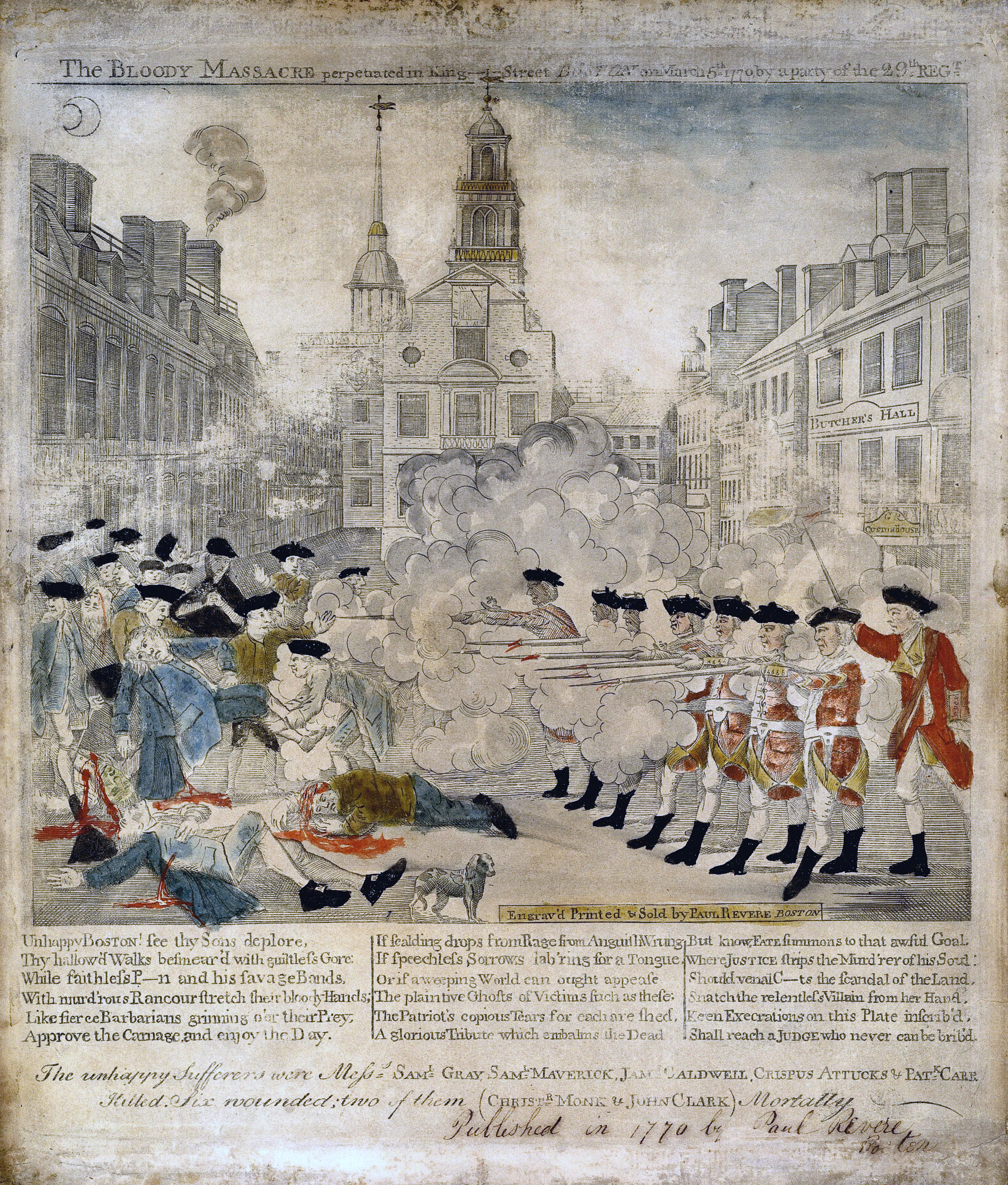
The Sons of Liberty immediately seized on the event, portraying the British soldiers as murderers and their victims as martyrs. Paul Revere, a silversmith and member of the Sons of Liberty, circulated an engraving that showed a line of grim redcoats firing ruthlessly into a crowd of unarmed, fleeing civilians. Among colonists who had begun to think of themselves as patriots, this view of the “massacre” confirmed their fears of a tyrannous government using its armies to attack their freedom. But to others, the mob was equally to blame for pelting the British with rocks and insulting them. John Adams, one of the city’s strongest supporters of peaceful protest against Parliament, represented the British soldiers at their murder trial. Adams said the soldiers were the tools of an unjust imperial policy. Of the eight soldiers on trial, the jury acquitted six, convicting the other two of the reduced charge of manslaughter. Long after the trial, the Sons of Liberty maintained a relentless propaganda campaign against British oppression. Newspaper articles and pamphlets implied that the “massacre” was a planned murder. In the Boston Gazette on March 12, 1770, an article described the soldiers as striking first. As it turned out, the Boston Massacre had actually happened after Parliament had already voted to partially repeal the Townshend Acts. By the late 1760s, the American boycott of British goods had drastically reduced British trade. Once again, merchants who lost money because of the boycott strongly pressured Parliament to loosen its restrictions and break the non-importation movement. Charles Townshend died suddenly in 1767 and was replaced by Lord North, who was more inclined to look for a solution with the colonists. North convinced Parliament to drop all the Townshend duties except the tax on tea. To those who had protested the Townshend Acts for several years, the partial repeal appeared to be a major victory. For a second time, colonists had rescued liberty from an unconstitutional parliamentary measure. The hated British troops in Boston departed. The consumption of British goods skyrocketed after the partial repeal, an indication of the American colonists’ continued desire to think of themselves as members of the Empire.
Questions for Discussion
- Which group do you think was more effective in the long run, the Sons or the Daughters of Liberty?
- Why do you think the colonists were so happy when the Townshend Acts were repealed?
